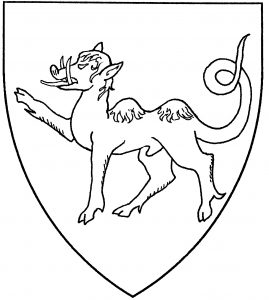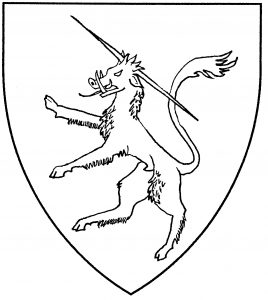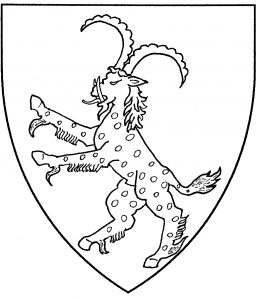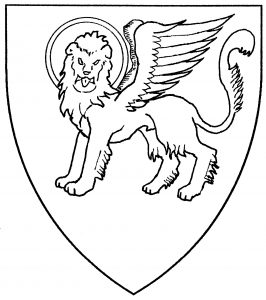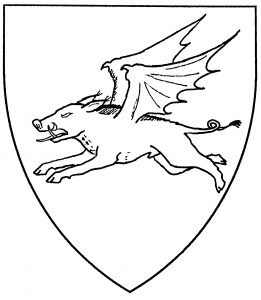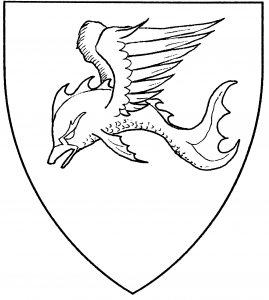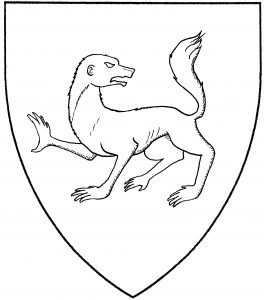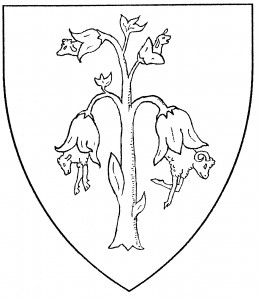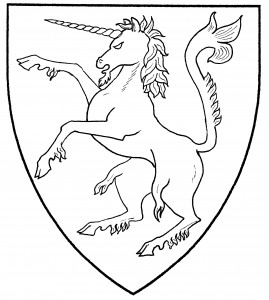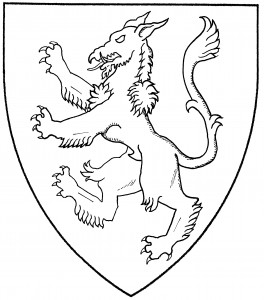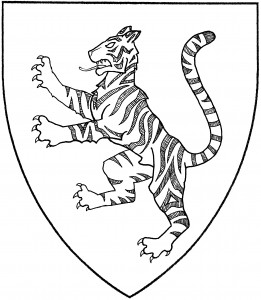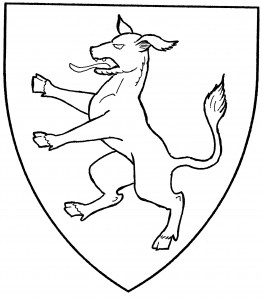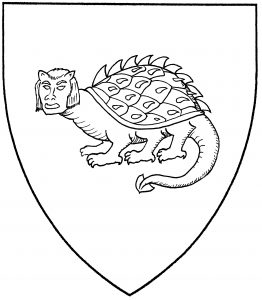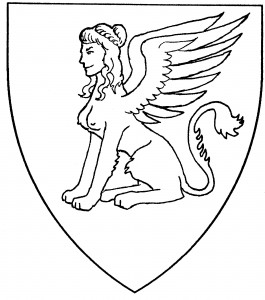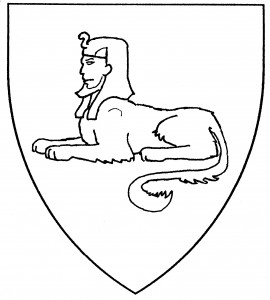The Canton of Attilium bears as a badge: An ypotryll passant Or.
Edelgard Erzsébet von Württemberg bears: Purpure, an ypotryll dormant Or.
Nina of Bright Hills bears: Or, a pale azure and overall an ypotryll rampant gules.
Archives
Yale
Two forms of yale are found in period heraldry [Dennys 165]. The earlier form, the “Bedford yale”, was one of the Duke of Bedford’s supporters c.1435, and resembles an antelope. The other form, the “Beaufort yale”, was used by his grandson Sir John Beaufort, c.1450; it is stockier, more like a goat, and is usually strewn with roundels. However, both yales have the characteristic horns and tusks; either type may be used in Society heraldry (and specified in blazon, if the submitter insists), but no difference is granted between them.
Jacinth Aldith de Warwick bears: Argent, a yale rampant sable, armed and attired Or, within a bordure compony erminois and vert.
Styrkárr Bjarnarson bears: Or, a yale rampant guardant vert bezanty armed gules.
Tristan le Chantecler de Champaigne bears: Barry azure and argent, two yales combatant Or.
Winged monsters
There are special terms for some winged monsters. A haloed winged lion may be blazoned a “lion of St. Mark”; it is found in the civic arms of Venice, 1413 [Conz.Const. cciii]. (St. Mark was the patron saint of the city.) A haloed winged ox may be blazoned an “ox of St. Luke”; it is found in the arms of Caravello, 1413 [Conz.Const. cliii]. Both evangelists’ monsters are frequently shown maintaining a book, that being their attribute, but such cases are nonetheless explicitly blazoned.
Rampant winged monsters may be blazoned “segreant”, since that term may be applied to any monster “half-bird, half-beast”; in that case, the posture of the wings is defined by the term. Winged monsters statant or couchant do not need their wings’ posture blazoned, either: the wings will be addorsed by default, that being their most distinguishable posture. The term “volant”, however, is ill-defined for non-birds, and should not be used for winged monsters; instead, the posture of the body should be blazoned in a standard way, with the wings’ position made explicit (e.g., a “winged lion courant, wings elevated and addorsed”).The illustrations show a lion of St. Mark statant guardant; a winged stag segreant; a bat-winged boar courant, wings elevated and addorsed; and a winged dolphin, wings addorsed. For specific entries, see humanoid monster (angel), pegasus, pithon. See also winged charges.
Jon de Cles bears: Gules, a winged camel trippant argent.
Jean Pierre de Sabre bears: Or, a winged fish volant sable.
Harold von Auerbach bears: Vert, a bat-winged boar salient argent.
Hastini Chandra bears: Or, an Indian elephant passant gules, winged sable.
Jamie MacRae bears: Purpure, a winged stag rampant to sinister argent.
Niall Kilkierny bears: Vert, a winged sea-lion rampant Or.
Werewolf
The werewolf has no default posture; the illustration shows a werewolf passant reguardant.
Jeanne Marie Lacroix bears as a badge: A werewolf passant reguardant vert.
Oddr Þiálfason bears as a badge: A werewolf passant sustaining over its shoulder a pole with a gonfanon dependent therefrom Or.
Vegetable lamb
The vegetable lamb is considered a monster in Society heraldry, a mythical plant bearing young sheep as its fruit. It was first mentioned in the Travels of Sir John Mandeville, c.1371, but does not appear in mundane armory.
Society blazon uses the phrase “fructed” to refer to the full blossom, including the sheep (e.g., when of another tincture than the rest of the plant). If only the sheep’s tincture differs, the phrase “fructed of sheep” is used: that is, a “vegetable lamb vert fructed sable” has black blossoms and sheep, bujt a “vegetable lamb vert fructed of sheep sable” has green blossoms and black sheep.
Lysander Keisalovitch bears: Argent, a vegetable lamb vert.
Solange Sarrazin bears: Or, a vegetable lamb vert, flowered gules and fructed of sheep argent, a chief indented azure.
Áine Táilliúir bears as a badge: A vegetable lamb Or fructed of sheep sable.
Unicorn
The unicorn is a fierce heraldic monster, named for the single horn growing from the center of its forehead; it was the medieval archetype of purity and chastity, and its horn was considered an antidote to poison. As an heraldic charge, it’s found as early as c.1340, in the arms of Tengen [Zurich 72].
The unicorn is always shown with its forward-pointing horn, which is its defining characteristic; it’s also drawn with cloven hooves. The usual English depiction gives it a body much like a horse’s, but with a bearded chin, a lion’s tail, and tufts at its feet (and frequently higher on the legs). The Continental depiction is based more on a goat, frequently with a goat’s tail (though a lion’s tail is common), and often no tufts or beard. The exact variant is not distinguished in blazon: either form is acceptable in the Society. Both forms are rampant by default, as in the illustration.
Modern fantasy art often depicts the unicorn as a horned horse, with long sweeping mane and tail; this is not the medieval concept of the unicorn, and so-called “unicornate horses” are no longer permitted in Society armory.
The March of the Unicorn bears: Gyronny of sixteen azure and argent, a unicorn rampant and in chief a laurel wreath Or.
Charles Edward Alexander Everman bears: Ermine, a unicorn rampant sable, armed and crined gules.
Henry Clarence bears: Argent, three unicorns passant azure.
Duncan MacDougall of Mendersham bears: Or, a unicorn rampant gules.
Tyger
The tyger is an heraldic monster, described as incredibly swift and deceitful; its body is much like that of the wolf, but it has a crest of tufts on the back of its neck, and a tusk pointing down from its nose. Medieval legend asserts that to escape a pursuing tyger, one must throw a mirror before it, so that it will be entranced by its reflection; indeed, the tyger in the arms of Sybell, 1531, is in just such a pose [Dennys 144]. The illustration shows a tyger rampant.
When blazoned a “natural tiger” or “Bengal tiger”, the term denotes a natural beast, the great cat Felis tigris: like a maneless lion, but with stripes on its coat. When blazoned “proper”, its coat is tawny, and the stripes black; this naturalistic coloring is no longer permitted in Society armory, but standard heraldic tinctures (e.g., “a Bengal tiger Or marked sable”) may still be used. The use of a Bengal tiger is considered a step from period practice. The illustration shows a Bengal tiger rampant.
The King of the East bears as a badge: A tyger passant azure.
Alia la rousse bears: Gules, in pale two tygers passant argent.
Sean Fitzwallace bears: Gules, a Bengal tiger rampant guardant proper within a bordure counter-compony argent and azure.
Theow
The theow, or thoye, is a rare monster resembling a mastiff or wolf, but with cloven hooves and a bovine muzzle and tail. It was used as a badge by Sir Thomas Cheney c.1560 [Dennys 161]. The theow does not seem to have a default posture; the illustration shows a theow rampant.
Fedora Phelan bears: Pily bendy sinister vert and argent, a theow rampant pean.
Flóki refskegg bears: Argent, a theow rampant sable collared and chained Or maintaining a grozing iron sable.
Eric of Nord Broc bears: Pean, a theow rampant and issuant from base a demi-sun argent.
Tarasque
The tarasque is an amphibious monster associated with Tarascon, France. Legends of the tarasque date from the 12th Century, frequently as part of the legend of St. Martha. It resembles a spiny-shelled tortoise with six legs; it’s often shown with a somewhat humanoid face. The tarasque is used in the modern arms of Tarascon, but no period heraldic examples have been found. The illustration shows a tarasque statant guardant.
Morgiane de Provence bears: Azure, a four-legged tarasque statant gardant contourny argent.
Spencer Alwyn bears: Quarterly azure and sable, a tarasque statant and in chief three mullets of four points argent.
Dawn Schadue bears as a badge: A tarasque passant vert vorant of two human legs clothed azure.
Sphinx
The sphinx is a monster from ancient myth, with a lion’s body and a human head. There are two forms of this monster, the Greek form and the Egyptian form, both of which date from antiquity.
The Greek sphinx (the riddling monster slain by Oedipus) is winged, and has a woman’s head and breasts; it’s the more common form, and the only form found in period heraldry. Blazoned simply as a “sphinx” in period, it is sometimes blazoned in the Society as a “winged” or a “gyno-sphinx” (gyno, “woman”). The Greek sphinx was described in period tracts [Bossewell II.46], and was granted as a crest to Robert Parris in 1573 [Dennys 118].
The Egyptian sphinx is the monster whose statue is seen at Giza; it has a man’s head, wearing a pharaonic headdress, and has no wings. It’s sometimes blazoned an “andro-sphinx” (andro, “man”) in the Society. Though the statue was known, the Egyptian sphinx doesn’t seem to have been used in period armory.
Of course, Society armorists take pleasure in conflating the two forms, and examples of “Greek andro-sphinxes” and “Egyptian gyno-sphinxes” have been registered. Go figure.
Neither form of sphinx has a default posture in Society heraldry; the illustrations show a Greek sphinx sejant and an Egyptian sphinx couchant. For related charges, see chimera (German), lamia, manticore, man-tyger.
Ariadne Leontodes bears: Argent, a Greek sphinx rampant azure winged sable.
Eirene Korinthia bears: Purpure, a Greek sphinx sejant Or.
Khalil el-Hadji bears: Or, an Egyptian sphinx couchant azure between in chief two scimitars inverted, blades to center sable.
Mammarra Liona of Egypt bears: Azure, an Egyptian gyno-sphinx rampant Or.
